display PEUGEOT PARTNER TEPEE 2020 Owners Manual
[x] Cancel search | Manufacturer: PEUGEOT, Model Year: 2020, Model line: PARTNER TEPEE, Model: PEUGEOT PARTNER TEPEE 2020Pages: 216, PDF Size: 8.46 MB
Page 6 of 216
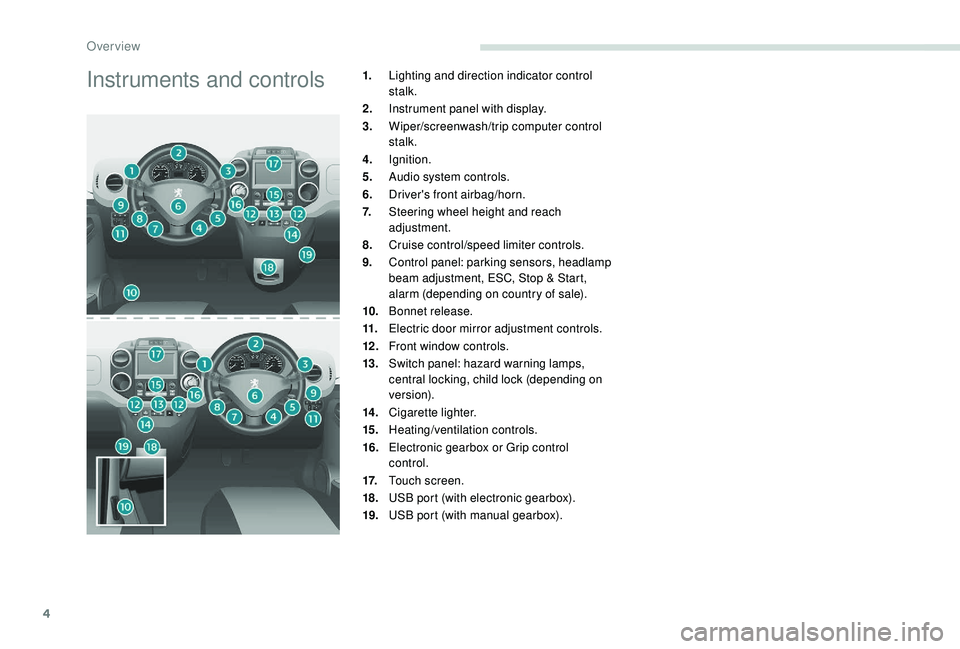
4
Instruments and controls1.Lighting and direction indicator control
stalk.
2. Instrument panel with display.
3. Wiper/screenwash/trip computer control
stalk.
4. Ignition.
5. Audio system controls.
6. Driver's front airbag/horn.
7. Steering wheel height and reach
adjustment.
8. Cruise control/speed limiter controls.
9. Control panel: parking sensors, headlamp
beam adjustment, ESC, Stop & Start,
alarm (depending on country of sale).
10. Bonnet release.
11. Electric door mirror adjustment controls.
12 . Front window controls.
13. Switch panel: hazard warning lamps,
central locking, child lock (depending on
ve r s i o n).
14 . Cigarette lighter.
15. Heating/ventilation controls.
16. Electronic gearbox or Grip control
control.
17. Touch screen.
18. USB port (with electronic gearbox).
19. USB port (with manual gearbox).
Over view
Page 7 of 216
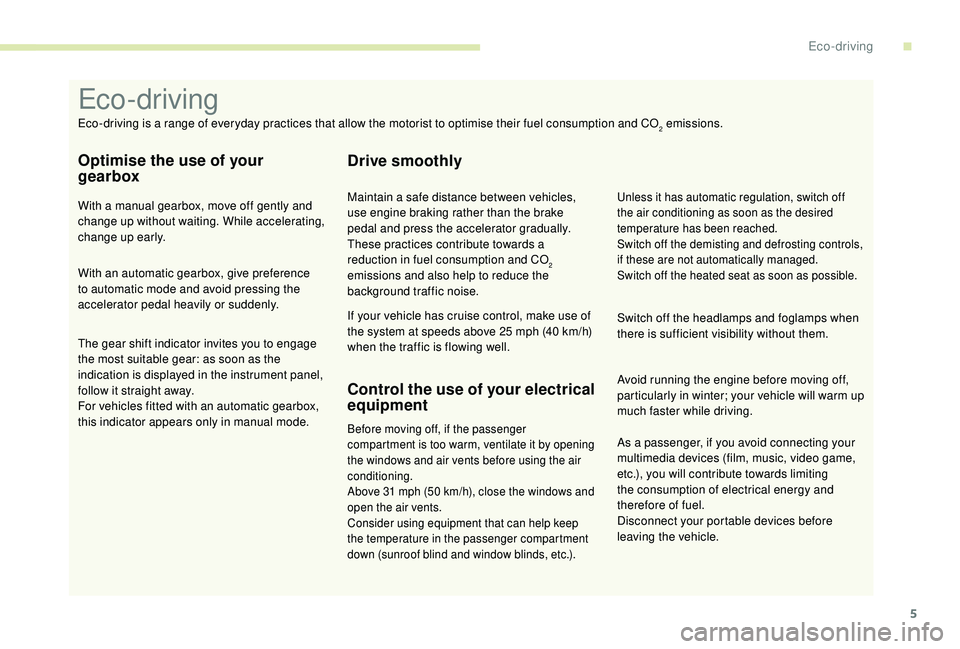
5
As a passenger, if you avoid connecting your
multimedia devices (film, music, video game,
etc.), you will contribute towards limiting
the consumption of electrical energy and
therefore of fuel.
Disconnect your portable devices before
leaving the vehicle.
Eco- driving
Eco-driving is a range of everyday practices that allow the motorist to optimise their fuel consumption and CO2 emissions.
Optimise the use of your
gearbox
With a manual gearbox, move off gently and
change up without waiting. While accelerating,
change up early.
With an automatic gearbox, give preference
to automatic mode and avoid pressing the
accelerator pedal heavily or suddenly.
The gear shift indicator invites you to engage
the most suitable gear: as soon as the
indication is displayed in the instrument panel,
follow it straight away.
For vehicles fitted with an automatic gearbox,
this indicator appears only in manual mode.
Drive smoothly
Maintain a safe distance between vehicles,
use engine braking rather than the brake
pedal and press the accelerator gradually.
These practices contribute towards a
reduction in fuel consumption and CO
2
emissions and also help to reduce the
background traffic noise.
If your vehicle has cruise control, make use of
the system at speeds above 25
mph (40 km/h)
when the traffic is flowing well.
Control the use of your electrical
equipment
Before moving off, if the passenger
compartment is too warm, ventilate it by opening
the windows and air vents before using the air
conditioning.
Above 31
mph (50 km/h), close the windows and
open the air vents.
Consider using equipment that can help keep
the temperature in the passenger compartment
down (sunroof blind and window blinds, etc.).
Switch off the headlamps and foglamps when
there is sufficient visibility without them.
Avoid running the engine before moving off,
particularly in winter; your vehicle will warm up
much faster while driving.
Unless it has automatic regulation, switch off
the air conditioning as soon as the desired
temperature has been reached.
Switch off the demisting and defrosting controls,
if these are not automatically managed.
Switch off the heated seat as soon as possible.
.
.
Eco-drivingsommaire
Page 9 of 216
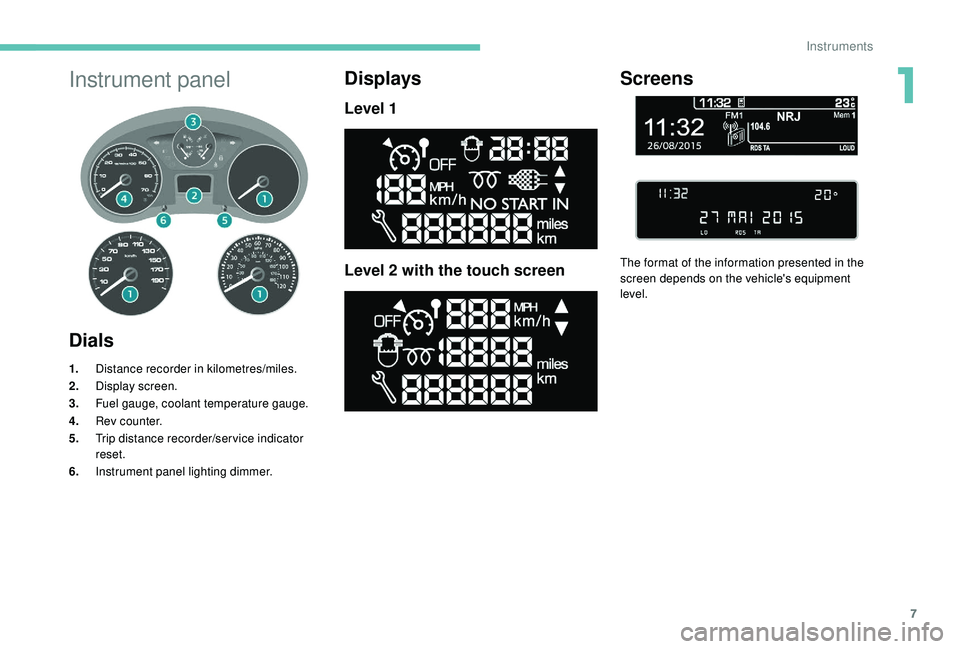
7
Instrument panel
Dials
1.Distance recorder in kilometres/miles.
2. Display screen.
3. Fuel gauge, coolant temperature gauge.
4. Rev counter.
5. Trip distance recorder/ser vice indicator
reset.
6. Instrument panel lighting dimmer.
Displays
Level 1
Level 2 with the touch screen
Screens
The format of the information presented in the
screen depends on the vehicle's equipment
level.
1
Instruments
Page 10 of 216
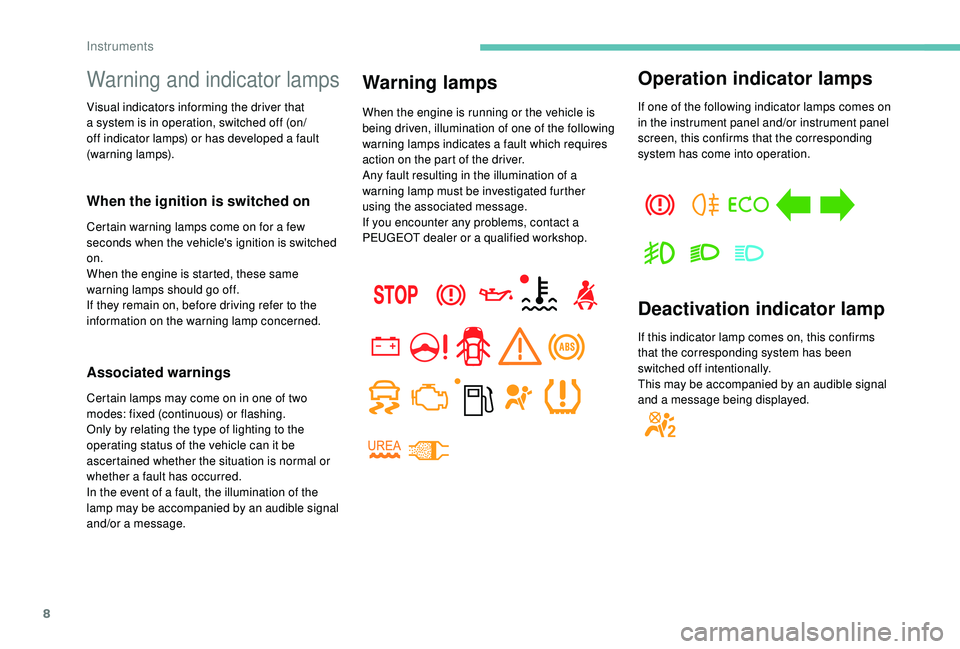
8
Warning and indicator lamps
Visual indicators informing the driver that
a system is in operation, switched off (on/
off indicator lamps) or has developed a fault
(warning lamps).
When the ignition is switched on
Certain warning lamps come on for a few
seconds when the vehicle's ignition is switched
on.
When the engine is started, these same
warning lamps should go off.
If they remain on, before driving refer to the
information on the warning lamp concerned.
Associated warnings
Certain lamps may come on in one of two
modes: fixed (continuous) or flashing.
Only by relating the type of lighting to the
operating status of the vehicle can it be
ascertained whether the situation is normal or
whether a fault has occurred.
In the event of a fault, the illumination of the
lamp may be accompanied by an audible signal
and/or a message.
Warning lamps
When the engine is running or the vehicle is
being driven, illumination of one of the following
warning lamps indicates a fault which requires
action on the part of the driver.
Any fault resulting in the illumination of a
warning lamp must be investigated further
using the associated message.
If you encounter any problems, contact a
PEUGEOT dealer or a qualified workshop.
Operation indicator lamps
If one of the following indicator lamps comes on
in the instrument panel and/or instrument panel
screen, this confirms that the corresponding
system has come into operation.
Deactivation indicator lamp
If this indicator lamp comes on, this confirms
that the corresponding system has been
switched off intentionally.
This may be accompanied by an audible signal
and a message being displayed.
Instruments
Page 13 of 216
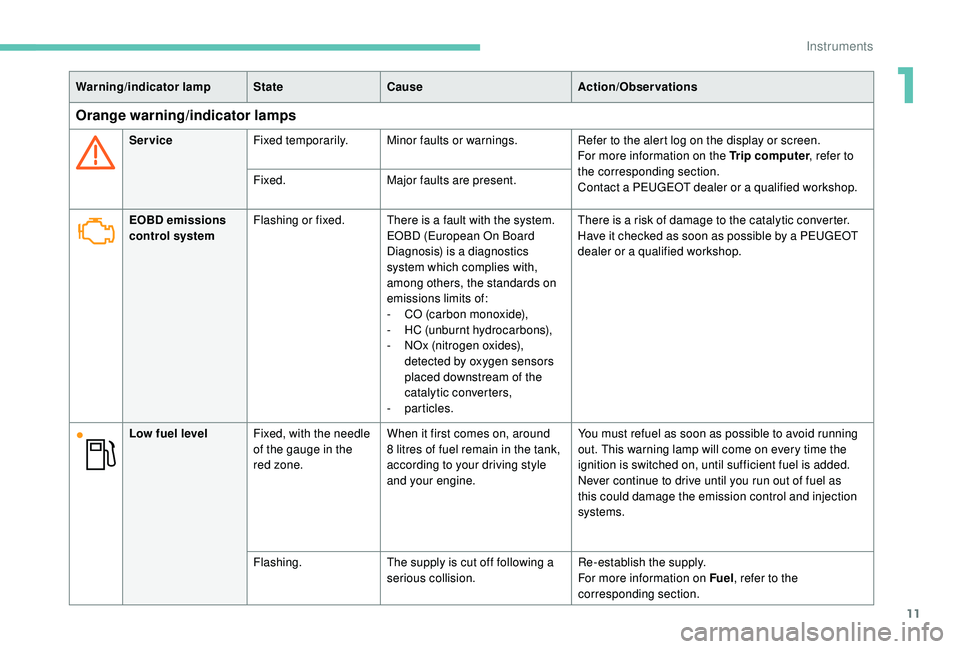
11
Warning/indicator lampStateCause Action/Observations
Orange warning/indicator lamps
ServiceFixed temporarily. Minor faults or warnings. Refer to the alert log on the display or screen.
For more information on the Trip computer , refer to
the corresponding section.
Contact a PEUGEOT dealer or a qualified workshop.
Fixed.
Major faults are present.
EOBD emissions
control system Flashing or fixed.
There is a fault with the system.
EOBD (European On Board
Diagnosis) is a diagnostics
system which complies with,
among others, the standards on
emissions limits of:
-
CO
(carbon monoxide),
-
H
C (unburnt hydrocarbons),
-
N
Ox (nitrogen oxides),
detected by oxygen sensors
placed downstream of the
catalytic converters,
-
particles.There is a risk of damage to the catalytic converter.
Have it checked as soon as possible by a PEUGEOT
dealer or a qualified workshop.
Low fuel level Fixed, with the needle
of the gauge in the
red zone. When it first comes on, around
8
litres of fuel remain in the tank,
according to your driving style
and your engine. You must refuel as soon as possible to avoid running
out. This warning lamp will come on every time the
ignition is switched on, until sufficient fuel is added.
Never continue to drive until you run out of fuel as
this could damage the emission control and injection
systems.
Flashing. The supply is cut off following a
serious collision. Re-establish the supply.
For more information on Fuel
, refer to the
corresponding section.
1
Instruments
Page 14 of 216
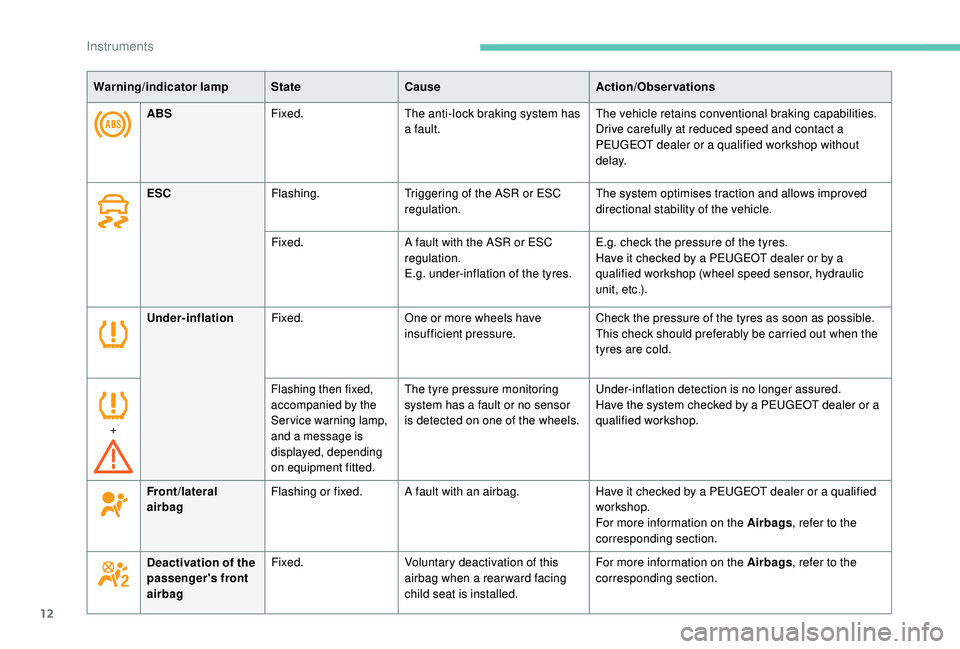
12
ABSFixed. The anti-lock braking system has
a fault. The vehicle retains conventional braking capabilities.
Drive carefully at reduced speed and contact a
PEUGEOT dealer or a qualified workshop without
d e l ay.
Warning/indicator lamp
StateCause Action/Observations
ESC Flashing. Triggering of the ASR or ESC
regulation. The system optimises traction and allows improved
directional stability of the vehicle.
Fixed. A fault with the ASR or ESC
regulation.
E.g. under-inflation of the tyres. E.g. check the pressure of the tyres.
Have it checked by a PEUGEOT dealer or by a
qualified workshop (wheel speed sensor, hydraulic
unit, etc.).
Under-inflation Fixed. One or more wheels have
insufficient pressure. Check the pressure of the tyres as soon as possible.
This check should preferably be carried out when the
tyres are cold.
+
Flashing then fixed,
accompanied by the
Service warning lamp,
and a message is
displayed, depending
on equipment fitted.The tyre pressure monitoring
system has a fault or no sensor
is detected on one of the wheels. Under-inflation detection is no longer assured.
Have the system checked by a PEUGEOT dealer or a
qualified workshop.
Front/lateral
airbag Flashing or fixed.
A fault with an airbag. Have it checked by a PEUGEOT dealer or a qualified
workshop.
For more information on the Airbags , refer to the
corresponding section.
Deactivation of the
passenger's front
airbag Fixed.
Voluntary deactivation of this
airbag when a rear ward facing
child seat is installed. For more information on the Airbags
, refer to the
corresponding section.
Instruments
Page 18 of 216

16
Warning/indicator lampStateIndicates Action/Observations
Dipped beam
headlamps/daytime
running lamps Fixed.
A manual selection or automatic
illumination. Rotate the lighting control stalk ring to the second
position.
Activation of the dipped beam
headlamps on switching on the
ignition: daytime running lamps
(depending on country of sale).
Blue warning/indicator lamps
Main beam
headlamps Fixed.
The lighting control stalk has
been pulled towards you. Pull the stalk to return to dipped beam headlamps.
Warning/indicator lamp in
the display screen State
Indicates Action/Observations
Cruise control Fixed. Cruise control is selected. Manual selection.
For more information on the Cruise control , refer to
the corresponding section.
Speed limiter Fixed. The limiter is selected. Manual selection.
For more information on the Speed limiter , refer to
the corresponding section.
Gear shift
indicator Fixed.
A recommendation which does
not take into account the road
configuration and the traffic
density. To reduce fuel consumption with a manual gearbox,
engage the appropriate gear. The driver remains
responsible for deciding whether or not to follow this
advice.
Instruments
Page 19 of 216
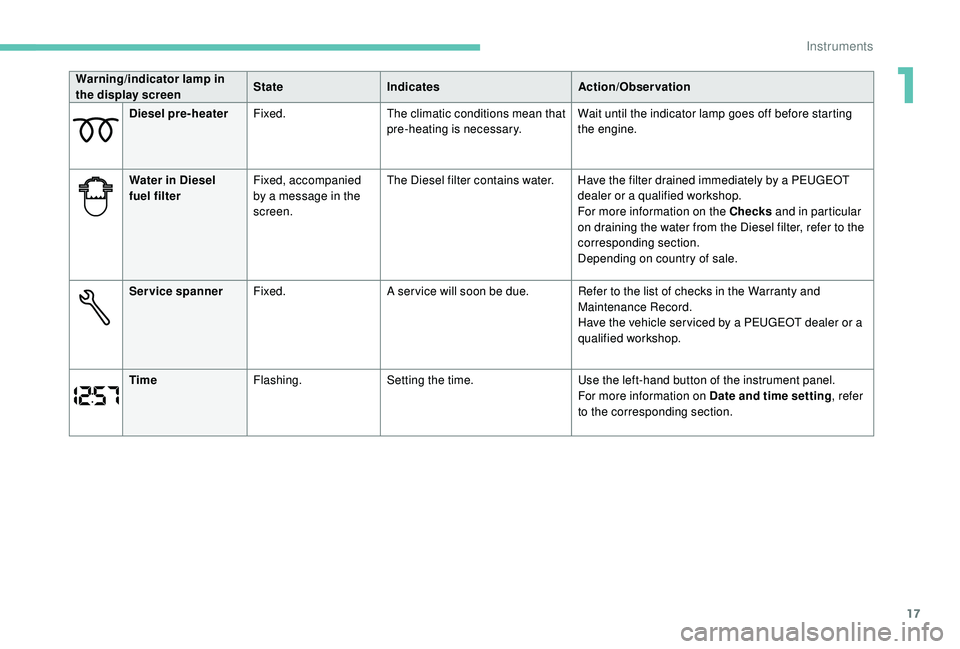
17
Diesel pre-heaterFixed. The climatic conditions mean that
pre-heating is necessary. Wait until the indicator lamp goes off before starting
the engine.
Water in Diesel
fuel filter Fixed, accompanied
by a message in the
screen. The Diesel filter contains water. Have the filter drained immediately by a PEUGEOT
dealer or a qualified workshop.
For more information on the Checks and in particular
on draining the water from the Diesel filter, refer to the
corresponding section.
Depending on country of sale.
Service spanner Fixed. A ser vice will soon be due. Refer to the list of checks in the Warranty and
Maintenance Record.
Have the vehicle ser viced by a PEUGEOT dealer or a
qualified workshop.
Time Flashing. Setting the time. Use the left-hand button of the instrument panel.
For more information on Date and time setting , refer
to the corresponding section.
Warning/indicator lamp in
the display screen
State
Indicates Action/Observation
1
Instruments
Page 20 of 216
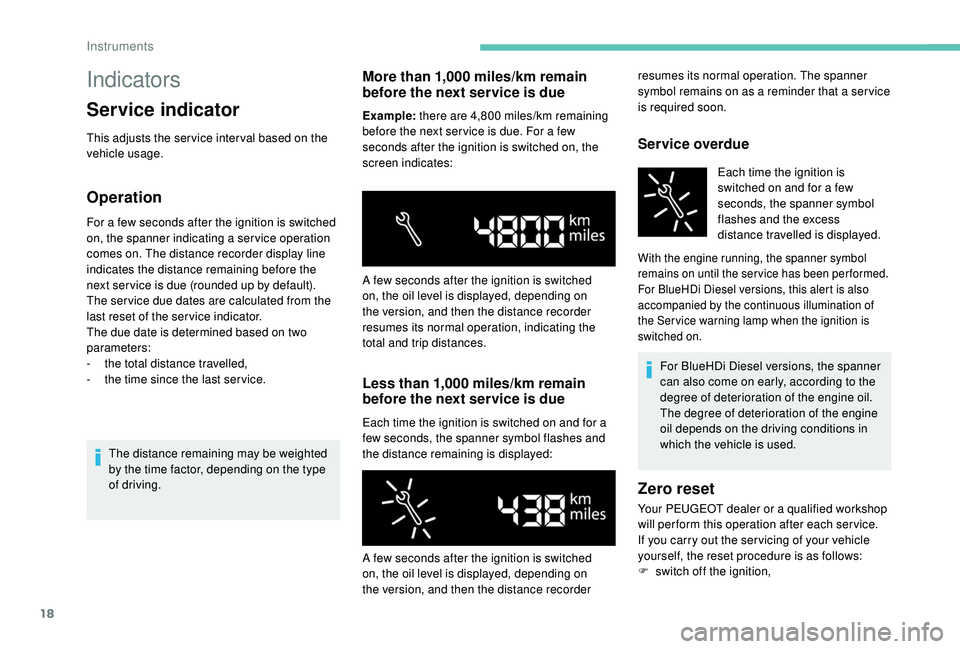
18
Indicators
Service indicator
This adjusts the ser vice inter val based on the
vehicle usage.
Operation
For a few seconds after the ignition is switched
on, the spanner indicating a ser vice operation
comes on. The distance recorder display line
indicates the distance remaining before the
next ser vice is due (rounded up by default).
The ser vice due dates are calculated from the
last reset of the ser vice indicator.
The due date is determined based on two
parameters:
-
t
he total distance travelled,
-
t
he time since the last ser vice.The distance remaining may be weighted
by the time factor, depending on the type
of driving.
More than 1,000 miles/km remain
b efore the next ser vice is due
Example: there are 4,800 miles/km remaining
before the next ser vice is due. For a few
seconds after the ignition is switched on, the
screen indicates:
Less than 1,000 miles/km remain
b efore the next ser vice is due
Each time the ignition is switched on and for a
few seconds, the spanner symbol flashes and
the distance remaining is displayed:
Service overdue
Each time the ignition is
switched on and for a few
seconds, the spanner symbol
flashes and the excess
distance travelled is displayed.
With the engine running, the spanner symbol
remains on until the ser vice has been per formed.
For BlueHDi Diesel versions, this alert is also
accompanied by the continuous illumination of
the Ser vice warning lamp when the ignition is
switched on.
For BlueHDi Diesel versions, the spanner
can also come on early, according to the
degree of deterioration of the engine oil.
The degree of deterioration of the engine
oil depends on the driving conditions in
which the vehicle is used.
A few seconds after the ignition is switched
on, the oil level is displayed, depending on
the version, and then the distance recorder
resumes its normal operation, indicating the
total and trip distances.
A few seconds after the ignition is switched
on, the oil level is displayed, depending on
the version, and then the distance recorder resumes its normal operation. The spanner
symbol remains on as a reminder that a ser vice
is required soon.
Zero reset
Your PEUGEOT dealer or a qualified workshop
will per form this operation after each ser vice.
If you carry out the ser vicing of your vehicle
yourself, the reset procedure is as follows:
F
s
witch off the ignition,
Instruments
Page 21 of 216

19
Following this operation, if you wish to
disconnect the battery, lock the vehicle
and wait at least five minutes for the reset
to be taken into account.
Engine oil level indicator
Depending on your vehicle’s engine, when the
ignition is switched on, the engine oil level is
indicated for a few seconds after the ser vice
information.
Oil level correctLow oil level
Oil level gauge fault
The level read will only be correct if the
vehicle is on level ground and the engine
has been stopped for more than thirty
minutes.
For more information on Checking the
levels
and, in particular, the oil level, refer
to the corresponding section.
The flashing of OIL- -
indicates a malfunction
of the engine oil level gauge. Contact a
PEUGEOT dealer or a qualified workshop. The flashing of OIL , together with the Ser vice
warning lamp, accompanied by an audible
signal and a message on the screen, indicates
a low oil level which could damage the engine.
If the low oil level is confirmed by checking with
the dipstick, the level must be topped up.
F
p
ress the trip distance recorder reset button
and keep it pressed,
F
s
witch on the ignition.
The distance recorder display begins a
countdown.
When the display indicates " =0", release the
button; the spanner disappears.
Trip recorder reset button
F With the ignition on, press the button until zeros
appear.
Fuel gauge
The fuel level is tested every time the ignition is
turned to the "on" position.
If the gauge is positioned on:
-
1 : t
he tank is full, about 60 litres.
-
0 : t
he use of the reser ve is started, the
warning lamp lights up permanently. When
the warning lamp comes on, the reser ve is
approximately 8
litres.
1
Instruments